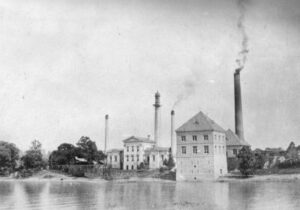 Louisville Water is celebrating a milestone birthday this week on Fri., Oct. 16 — 160 years of great water and great service. We wanted to share some of the important dates in our history.
Louisville Water is celebrating a milestone birthday this week on Fri., Oct. 16 — 160 years of great water and great service. We wanted to share some of the important dates in our history.
- 1860: Louisville Water Company begins operations with 512 customers.
- 1879: The 110-million-gallon Crescent Hill Reservoir opens. It lets the muddy Ohio River water settle longer and is on a higher elevation than the first reservoir to provide more water for the city.
- 1890: A massive tornado destroys the Louisville Water Tower. It will take until the end of the decade for the tower to be completely rebuilt with the current statues.
- 1893: Pumping Station No. 2 begins operation. It houses a steam pump that can pump 16 million gallons a day, more than twice the amount of the first two Cornish pumps.
- 1895: George Warren Fuller begins filtration experiments to determine the best and most economical way to filter Ohio River water. Today, Fuller’s three part system is the basis for modern water filtration.
- 1906: The city of Louisville buys the last of the original 51 shares of Louisville Water that were owned by private investors. Louisville is the sole shareholder today.
- 1909: The Crescent Hill Water Treatment Plant goes online with six filters. Within a year, Louisville’s typhoid death rate drops 60 percent.
- 1914: To better disinfect the water, chlorine is added for the first time.
- 1917: Camp Zachary Taylor, the World War I training camp, is built in Louisville. The government cites one of the reasons as the “almost perfect” water.
- 1919: To keep up with a growing demand for water, Pumping Station No. 3 begins operations.
- 1928: The first electric pump goes online. A gift from LG&E so Louisville Water will buy their electricity, the 60-million-gallons-a-day pump signals the beginning of the end for the age of steam.
- 1937: Louisville’s worst flood nearly shuts down the pumping stations for weeks. Water rises 54 inches inside the stations. A steamboat provides power to one of the steam pumps, preventing the total loss of water to the city.
- 1940: After more than a half-century of complaints about water waste by customers who paid a flat rate for service, all water usage is measured by meter. Customers pay for the water they use.
- 1941-45: At least 46 Louisville Water employees serve in the military during World War II. For a scrap drive in 1942, 13 Louisville Water trucks parade through towns with 60 tons of metal donated to the war effort.
- 1964: To increase sales, water is sent out of Jefferson County for the first time.
- 1972: Pumping Station No. 1 and the Louisville Water Tower are named a National Historic Landmark.
- 1974: A tornado hits the Crescent Hill Water Treatment Plant. Damage to the buildings is light, but electricity to the pumping station is knocked out. It takes LG&E crews nearly 12 hours to restore the power.
- 1978: To reduce main breaks and maintain infrastructure, the Main Rehabilitation and Replacement Program begins.
- 1978: A new pumping station on the Ohio River, the B. E. Payne Water Treatment Plant, opens to supply water primarily to the growing number of users in the east end of Jefferson County and beyond.
- 1979: The Crescent Hill Reservoir, Gatehouse, and Shelter House are added to the National Register of Historic Places.
- 1980: People Magazine runs an article on the best-tasting tap water in the U.S. Louisville ties with Seattle for first place.
- 1997: We brand our water as Louisville pure tap®.
- 2000: After nearly 40 years of purchasing and merging with smaller water districts, the countywide extension of Louisville Water’s service area is complete.
- 2002: Louisville Water launches education efforts, including the Adventures in Water festival, with STEM-based curriculum for teachers and activities for grades 3 to 7.
- 2010: Riverbank Filtration, a combination of four collector wells and a tunnel, begins operating at the B. E. Payne Water Treatment Plant. Raw water drawn from the aquifer is nearly ready to drink. The newly open plant wins a Phase IV Award in water treatment.
- 2011: Riverbank Filtration wins the Best Civil Engineering Project Award.
- 2012: Louisville Water goes green and promotes use of reusable water bottles. The company also starts offering pure tap® mobile units and branding fountains.
- 2014: The WaterWorks Museum opens to rave reviews. Restoration of Pumping Station No. 1 wins Kentucky’s preservation award.
- 2015: The reworked Crescent Hill Water Treatment plant wins the prestigious Phase IV Award and Louisville Water becomes one of only two utilities with two Phase IV awards for water treatment.
- 2020: The three-year project involving slip lining the nearly century old 48-inch main along Eastern Parkway is completed. This is the largest water main renovation and replacement in the company’s history. In addition, the last known lead service line is removed from Louisville Water’s system. This multi-year project was sped up by five years.

